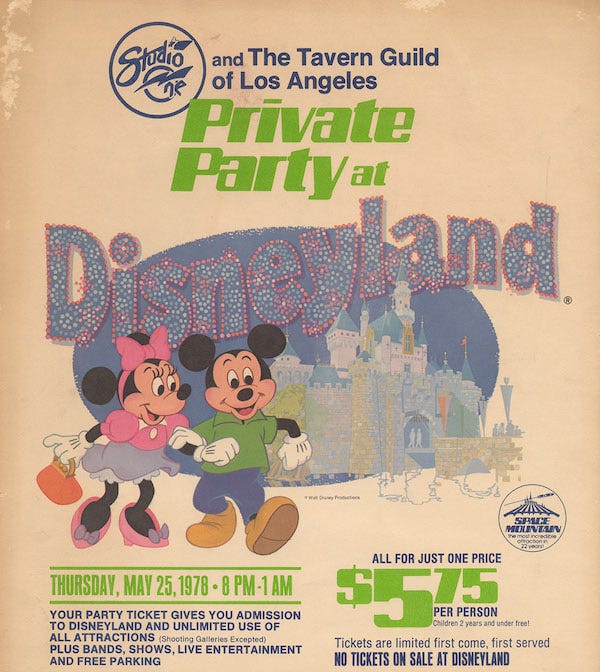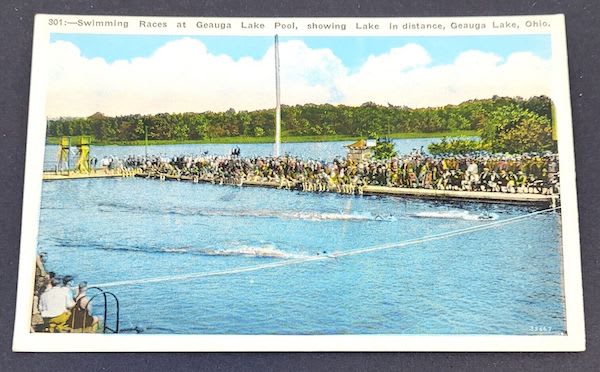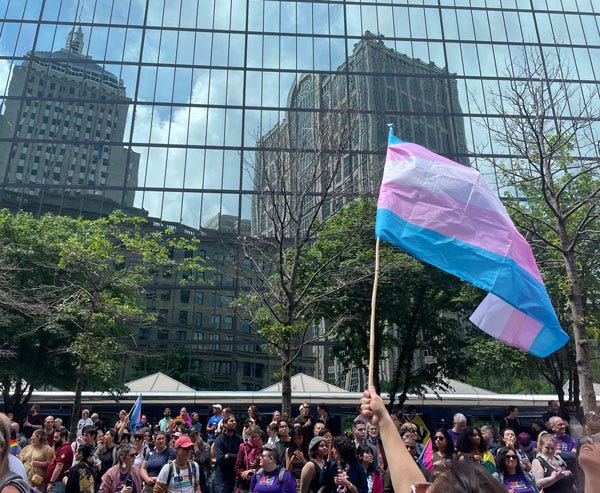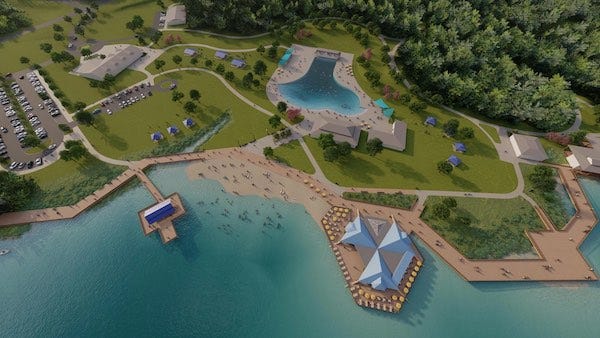Wednesday Walk: Pride and Parks
Looking at Pride Month from Boston to Disneyland and the retro rebirth of an Ohio amusement park
Welcome to Willoughby Hills!
Before we get started on this week’s Wednesday Walk, I wanted to say a quick thank you to all of the paying members of Willoughby Hills! Substack (the platform which hosts this newsletter and podcast) emailed me this week to let me know that I reached a milestone in terms of paid members, which was thrilling news to receive and helped validate the hard work that I put into this publication. A special shout out two latest people to upgrade to paid memberships: welcome aboard Jesse and Jason!
If you enjoy what you’re reading, please consider a free subscribtion to receive emails every Wednesday and Sunday plus podcast episodes every two weeks. There are also paid options, which unlock even more features.
Now, shall we take a stroll?
A Day of Pride
On Saturday, we marched in Boston’s Pride for the People Parade with a group representing my children’s school. I honestly didn’t know what to expect as it was not only our first time marching in any parade as a family. It was also the first Boston Pride Festival in three years, after accusations in 2020 that parade organizers were excluding trans people and people of color.
I’ve written about the importance of parades in communities before and bemoaned how my kids have only experienced parades in corporate settings like amusement parks, so it was nice to be a part of a community event like this.
I’ll have to admit though, I did have some reservations about the parade and the potential for protests or even violence.
As we lined up on Boylston Street, I was very aware that we were just one block from where three people were killed at the Boston Marathon finish line in 2013. My mind also went to ways the LGBT+ community has been the target of violent attacks, from the Pulse shooting in Orlando in 2016 to this year’s bomb threats against Target stores. (In the case of Target, the stores had pulled some Pride merchandise after complaints, and the bomb threats seemed to have come from people who were angry that Target acquiesced to right wing pressure.)
Of course, any fears I had about the parade went away as soon as we stepped off and we were greeted by a sea of humanity. People of all ages, races, and orientations gathered along the parade route to watch and to cheer on the marchers.
My kids’ school was represented only by a banner that students carried, plus some flags that people waved. We had no elaborate float, no marching band, we weren’t even tossing out candy (although we did hand out some stickers to children). Yet, the amount of positive energy we received from the crowd was overwhelming. People were cheering for us, clapping, and smiling just because we showed up.
What I found the most affirming part of the whole day was looking into the eyes of the spectators as we passed them. I would smile and wave and try to look as many people as possible directly in the eyes and make a connection. There were older gay and lesbian couples, younger gay couples with small children in tow, Black people, Brown people, White people, even furries wearing masks that resembled sports mascots. And in that brief moment of sharing eye contact, we were humans sharing this same earth, despite what might be superficial differences.
And going back to the idea that I discussed last week about how I see a rainbow harvest on local farms as a sign of Mother Nature’s support for the LGBT+ community, I couldn’t help but overlook the symbolism that Saturday morning started as a gray and dreary day in Boston, but about 5 minutes before the parade stepped off, the sun suddenly came out from behind the clouds and it stayed sunny for our entire march.
Disney’s History of Pride
If you visit ShopDisney.com, the online successor to the Disney Store (whose physical presence is down to just a handful of stores), you’ll be greeted by a full page spread of merchandise celebrating Pride (or at least that was the case yesterday morning when I captured this screenshot):
Disney has been in the spotlight after then (now former) CEO Bob Chapek spoke out last year against Florida’s legislation banning discussion of sexual orientation and gender identity in schools. This set off a tidal wave of animosity back and forth between Tallahassee and Burbank resulting in the Florida legislature stripping Disney of its special administrative status earlier this year.
However, Disney’s support of LGBT+ rights actually goes back way, way further.
Last night, Disneyland hosted its first official Pride event (here’s a Twitter thread with some of the highlights), although there have been unofficial Pride events in the Parks for years. Today I wanted to share an interesting article from Bethanee Bemis (the historian who I interviewed on the podcast) about the history of gay events at Disney theme parks.
It turns out that the first time Disneyland hosted a party for the gay community dates back to 1978. According to Bemis:
“Scott Forbes, the owner of Studio One, a popular Los Angeles gay bar, with the help of Carol DiPietro, a Disneyland employee, booked the park for a private party on the evening of May 25, 1978. At this time, Disneyland was often rented to private groups in the evenings as a way of generating extra income… What made the May 25th booking, known on the official Disneyland calendar as a private party for the L.A. Restaurant Association, different from the others is that the party was marketed almost exclusively to the gay community. Flyers promoted it as a private party for ‘Studio One and The Tavern Guild of Los Angeles.’ The Tavern Guild of Los Angeles was an organization of gay bar owners and employees and, as noted, Studio One was a popular gay bar.”
When the identity of the group behind the event was revealed, Disney feared backlash. They looked into their options for cancelling, but lawyers advised that it would violate the contract signed by both groups.

Bemis also quoted from conversations she had with Bob Gurr, an openly gay Imagineer who worked with Walt Disney designing iconic rides like the Matterhorn, and here is how she summarized his recollections:
“Management’s first concern was that they’d be asking employees to work a party whose very nature went ‘against their beliefs and religions.’ Instead, when the shift was offered ‘they got so many volunteers to work that night!’-much to management’s surprise.”
Supposedly, on the morning after the event, the park was left so clean that management decided that they would welcome the LGBT+ community for similar events thereafter, a tradition which ran until 1998 when Disneyland ceased the practice of renting space for private parties and it was revealed that charitable donations promised by event organizers weren't being used appropriately.
Bemis’s article goes on to discuss the history of Walt Disney World’s similar Gay Days, how these events went from underground to mainstream, and what that says about our larger cultural shifts over the last 45 years. She also discusses some of the anti-same sex policies that the parks had during the same time and what ultimately led to their dismantling.
It’s an interesting read, and one that has been on my mind after the Pride parade this weekend. It’s also a good reminder that (despite recent examples like Target and Bud Lite), doing meaningful outreach to specific communities beyond the presumed “default” can lead to more business and strong brand allegiance. (In America, that default is almost always white, straight, and usually male).
You can read the full article here.
Another Amusement Revival?
Today’s last item takes us to another amusement park, or in this case, a former amusement park. Growing up, there was nothing better than a day spent at Geauga Lake, a regional theme park in Aurora, Ohio.
I started visiting Geauga Lake from a very young age when my grandpa’s company would have corporate picnics in the park. My grandparents would take my sister and me on the kiddie rides like the “Merry Oldies” old fashioned cars or the little boats that spin in a circle while my parents would ride roller coasters.
Geauga Lake’s history mirrors that of many regional amusement parks of the era. It began as a natural body of water in the countryside that people would visit for its own sake. It gained popularity because it had train access to Cleveland and the surrounding suburbs. By the late 1800s, a hotel and a steam powered carousel were added, followed by a wooden roller coaster (known as The Big Dipper) in 1925, and a dance pavilion in 1939.
In 1970, Sea World opened their second location across the lake from the Geauga Lake amusement park (after their first in San Diego). I never quite understood why Sea World thought that an aquatic park in an area with four seasons (one of which is a very cold winter) made sense, although subsequent locations would open in San Antonio and Orlando, so maybe Sea World learned their lesson in Ohio.
Geauga Lake’s parent company was purchased by Six Flags in 1995 and the park was later rebranded as Six Flags Ohio, then Six Flags Worlds of Adventure once the company also acquired the Sea World parcel. Under Six Flags ownership many new roller coasters and thrill rides were added, perhaps in an attempt to compete with nearby Cedar Point.
Both the former Geauga Lake and Sea World sites were sold to Cedar Point’s parent company Cedar Fair, who operated Geauga Lake for another four years before ceasing operations in 2007. (A small waterpark would later operate on a portion of the Sea World location until 2016).
The park relocated or auctioned off many of its old rides, but some just sat abandoned for years and years, including the iconic Big Dipper coaster from 1925. The park became notorious for urban explorers, who documented the sorry state on YouTube.
Eventually, some of the area around the former amusement park was developed into housing and retail, but not entirely.
I share all of this history to put into context the latest news out of Geauga Lake: it may be headed for a comeback! Well, sort of.
According to a report from Kabir Bhatia for Ideastream Public Media (the Northeast Ohio PBS provider), there is currently a proposal from the mayor of Aurora to have the city purchase a lakefront parcel on Geauga Lake and create a public park which would include a swimming pool, visitor center, beach, and even non-motorized boating. In other words, Geauga Lake might return to its roots as a simple, local, and largely nature-based attraction.
It’s an interesting twist of fate for an area that holds a lot of fond memories for me but that has struggled to remain relevant in the twenty-first century. And frankly, it’s interesting to me how the pendulum has swung the other way in terms of what makes a meaningful attraction. The lake was the primary attraction in the early days of the park, but by the time I remember visiting, it was more of a backdrop than anything else. There may have been a boat ride of some kind in my childhood, but the lake was certainly not open to recreation by the 1980s.
Regional parks like Geauga Lake were once ubiquitous. Some were built as “trolley parks” by the railroad companies to encourage weekend ridership on their lines. Many thrived in the early part of the twentieth century at a time where a simple roller coaster, carousel, and a bandstand and dance hall constituted a day out. Few remain to this day.

The proposal to redevelop Geauga Lake is currently with the City Council of Aurora. I hope the enduring fun of the lake is preserved for future generations in some form. It may not be the same place that I remember, but keeping it in the hands of the public would be a huge victory in my book!
What are your thoughts? Leave a comment below- I love hearing from you!
I publish new issues every Wednesday and Sunday. Sign up to always receive the latest issue and support my work:
Other Wednesday Walks
If you’ve missed past issues of this newsletter, they are available to read here.











Heath, thanks as always. My wife has been an Aurora resident her whole life, and 27 years for me. If the community can pull off the Geauga Lake project it will be wonderful. It's been sad to see that beautiful property go unused for the past 7 years.
Happy Pride! I’ll share more about our parade on Friday, but it was so liberating and I’m glad y’all were able to restore yours!
Also, Starbucks has now joined the backlash 🤬.